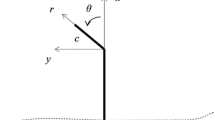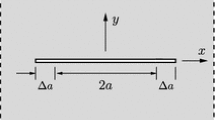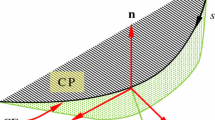Abstract
There are several criteria for predicting brittle fracture in mode I and mixed mode loading. In this paper, the modified maximum tangential stress criterion originally proposed for mixed mode loading, is employed to study theoretically brittle fracture for mode I cracks. In particular, the effect of the non-singular term of stress, often known as the T-stress, on the angle of initiation of fracture and the onset of crack growth is explored. The T-stress component of the tangential stress vanishes along the crack line. Therefore, it is often postulated for linear elastic materials that the effect of T-stress on mode I brittle fracture can be ignored. However, it is shown here that the maximum tangential stress is no longer along the line of initial crack when the T-stress exceeds a critical value. Thus, a deviation in the angle of initiation of fracture can be expected for specimens having a large T-stress. It is shown that the deviation angle increases for larger values of T-stress. Theoretical results show that the apparent fracture toughness decreases significantly when a deviation in angle occurs. Earlier experimental results are used to corroborate the findings. The effect of large T-stresses is also explored for a crack specimen undergoing moderate scale yielding. The elastic-plastic investigation is conducted using finite element analysis. The finite element results reveal a similar deviation in the angle of maximum tangential stress for small to moderate scale yielding.
Similar content being viewed by others
References
Andrews, R.M. and Garwood, S.J. (2001). An analysis of fracture under biaxial loading using the non-singular T-stress. Fatigue and Fracture of Engineering Materials and Structures 53, 53–62.
ANSYS V5.4 (1994). Swanson Analysis Systems Inc., USA.
Ayatollahi, M.R., Pavier, M.J. and Smith, D.J. (1998). Determination of T-stress from finite element analysis for mode I and mixed mode I/II loading. International Journal of Fracture 91, 283–298.
Ayatollahi, M.R., Smith, D.J. and Pavier M.J. (2001). Effect of higher order stresses in an internal crack problem. IUST International Journal of Engineering Science 12, 53–66.
Ayatollahi, M.R., Smith, D.J. and Pavier, M.J. (2002). Crack tip constraint in mode II deformation. International Journal of Fracture 113(2), 153–173.
Betegon, C. and Hancock, J.W. (1991). Two-parameter characterization of elastic-plastic crack-tip fields. Journal of Applied Mechanics 58, 104–110.
Bilby, B.A., Cardew, G.E., Goldthorpe, M.R. and Howard, I.C. (1986). A finite element investigation of the effect of specimen geometry on the fields of stress and strain at the tips of stationary cracks. Size Effect in Fracture. IMechE, UK, 37–46.
Chao, Y.J and Zhang, X.H. (1997). Constraint effect in brittle fracture. Fatigue and fracture Mechanics: 27th Symposium, ASTM STP 1296, R.S. Piascik, J.C. Newman and D.E. Dowling (eds), American Society for Testing and Materials, 41–60.
Chao, Y.J., Liu, S. and Brovial, B.J. (1999). Variation of fracture toughness with constraint of PMMA specimens. Proceedings of ASME-PVP Conference 393, 113–120.
Cotterell, B. (1966). Notes on the paths and stability of cracks. International Journal of Fracture Mechanics 2(3), 526–533.
Cotterell, B. and Rice, J.R. (1980). Slightly curved or kinked cracks. International Journal of Fracture 16(2), 155–169.
Erdogan, F. and Sih, G.C. (1963). On the crack extension in plates under plane loading and transverse shear. Journal of Basic Engineering, Transactions of ASME 85, 519–527.
Finnie, I. and Saith, A. (1973). A note on the angled crack problem and the directional stability of cracks. International Journal of Fracture 9, 484–486.
Haefele, P.M. and Lee, J.D. (1995). The constant stress term. Engineering Fracture Mechanics 50(5/6), 869–882.
Larsson, S.G. and Carlsson, A.J. (1973). Influence of non-singular stress terms and specimen geometry on smallscale yielding at crack tips in elastic-plastic materials. Journal of the Mechanics and Physics of Solids 21, 263–277.
Leevers, P.S. and Radon, J.C. (1982). Inherent stress biaxiality in various fracture specimen geometries. International Journal of Fracture 19, 311–325.
Leevers, P.S., Radon, J.C. and Culver, L.E. (1976). Frature trajectories in a biaxially stressed plate. Journal of the Mechanics and Physics of Solids 24, 381–395.
O'Dowd, N.P. and Shih, F.C. (1991). Family of crack-tip fields characterized by a triaxiality parameter-I. Structure of field. Journal of the Mechanics and Physics of Solids 39(8), 989–1015.
O'Dowd, N.P. and Shih, F.C. (1992). Family of crack-tip fields characterized by a triaxiality parameter-II. Fracture applications. Journal of the Mechanics and Physics of Solids 40(5), 939–963.
Rice J.R. (1968). A path independent integral and the approximate analysis of strain concentration by notches and cracks. Journal of Applied Mechanics 35, 379–386.
Ritchie R.O., Knott J.F. and Rice J.R. (1973). On the relationship between critical stress and fracture toughness in mild steel. Journal of the Mechanics and Physics of Solids 21, 395–410.
Smith, D.J., Ayatollahi, M. R. and Pavier, M.J. (2001). The role of T-stress in brittle fracture for linear elastic materials under mixed mode loading. Fatigue and Fracture of Engineering Materials and Structures 24(2), 137–150.
Streit, R. and Finnie, I. (1980). An experimental investigation of crack-path directional stability. Experimental Mechanics 20(1), 17–23.
Ueda, Y., Ikeda, K., Yao, T. and Aoki, M. (1983). Characteristics of brittle fracture under general combined modes including those under bi-axial tensile loads. Engineering Fracture Mechanics 18(6), 1131–1158.
Williams, M.L. (1957). On the stress distribution at the base of a stationary crack. Journal of Applied Mechanics 24, 109–114.
Williams, J.G. and Ewing, P.D. (1972). Fracture under complex stress - the angled crack problem. International Journal of Fracture 8, 441–446.
Author information
Authors and Affiliations
Rights and permissions
About this article
Cite this article
Ayatollahi, M., Pavier, M. & Smith, D. Mode I cracks subjected to large T-stresses. International Journal of Fracture 117, 159–174 (2002). https://doi.org/10.1023/A:1020973802643
Issue Date:
DOI: https://doi.org/10.1023/A:1020973802643




